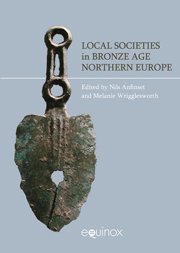Book contents
- Frontmatter
- Contents
- List of figures and tables
- Contributors
- Acknowledgements
- Introduction: local societies, regions and processes of cultural interaction in the Bronze Age
- PART I IDENTITY, GRAND NARRATIVES AND NETWORKS
- 1 Approaching a complex past: entangled collective identities
- 2 Asymmetric twins? Some reflections on coastal and inland societies in the Bothnian area during the Epineolithic and Early Metal Age
- 3 Expressing identity through ritual in the Early Bronze Age
- 4 Large-scale “grand narratives” and small-scale local studies in the Bronze Age discourse: the animal perspective
- 5 Reconsidering a periphery: scenarios of copper production in southern Norway
- 6 On the bronze trail: short-cuts, byways, transformation and displacement
- PART II REGIONS, GLOBALIZATION AND RESISTANCE
- Index
4 - Large-scale “grand narratives” and small-scale local studies in the Bronze Age discourse: the animal perspective
from PART I - IDENTITY, GRAND NARRATIVES AND NETWORKS
- Frontmatter
- Contents
- List of figures and tables
- Contributors
- Acknowledgements
- Introduction: local societies, regions and processes of cultural interaction in the Bronze Age
- PART I IDENTITY, GRAND NARRATIVES AND NETWORKS
- 1 Approaching a complex past: entangled collective identities
- 2 Asymmetric twins? Some reflections on coastal and inland societies in the Bothnian area during the Epineolithic and Early Metal Age
- 3 Expressing identity through ritual in the Early Bronze Age
- 4 Large-scale “grand narratives” and small-scale local studies in the Bronze Age discourse: the animal perspective
- 5 Reconsidering a periphery: scenarios of copper production in southern Norway
- 6 On the bronze trail: short-cuts, byways, transformation and displacement
- PART II REGIONS, GLOBALIZATION AND RESISTANCE
- Index
Summary
Body and mind
Towards the end of the conference “Regions on the periphery of Bronze Age Northern Europe”, one of the participants commented, in some distress, that we need to figure out this gap between local and inter-regional Bronze Age studies. The gap referred to is a discrepancy between large-scale “grand narratives” and small-scale local studies in the Bronze Age discourse. This chasm separates two different research approaches: large-scale versus small-scale processes. By using animals as a focal point, I will discuss the differences of these approaches, their language and their aims. I also want to suggest a way to integrate both perspectives with a third overlooked arena – the household practice.
I have previously compared the Bronze Age discourse to the idea of a body/mind dichotomy (Armstrong Oma 2008). From a meta-perspective, Bronze Age research can today be seen as a set of binary contrasts, comparable with the Cartesian dualism. Descartes's famous cogito sentence created a separation between the corporeal body and the rational mind, which led to a conceptual purification – in short, lots of hassle for philosophers trying to create a pure category. Regarding Bronze Age studies, I suggest that micro-scale studies that amass a body of material can be likened to the body, and the supposed world of ideas in the Bronze Age universe represents the mind.
This polarization is found between two camps that do not communicate very well.
- Type
- Chapter
- Information
- Local Societies in Bronze Age Northern Europe , pp. 71 - 88Publisher: Acumen PublishingPrint publication year: 2012

